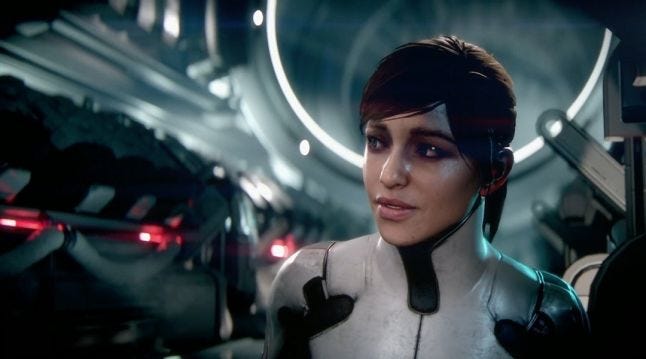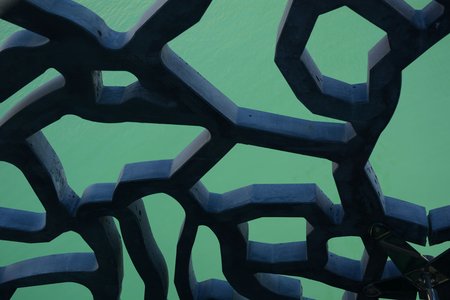This roundtable is reprinted with permission from AnimState.
With so much attention being paid in the last week to the animation issues seen in the previews leading up to Bioware's next big release, Mass Effect: Andromeda, we thought it would be interesting to get a few experienced animators together to discuss the challenges animators face when dealing with these types of projects. Also, a special thanks to Daniel Floyd for moderating this round table for us. So, let's get to the introductions!
Dan Floyd: I guess I'll start things off, since I'm mostly here to moderate and ask the smarter people questions. I'm Dan Floyd, I co-run a YouTube channel called Extra Credits and make a show on that channel about game animation called Extra Frames. I'm also an animator with film and game industry experience, but not nearly as much as my counterparts here.
Simon Unger: Hey! I'm Simon Unger! I'm an animator at Phoenix Labs working on a new game called Dauntless. Prior to that, I was a lead animator at Electronic Arts, Square Enix, and Robotoki. I've also taught at schools such as Gnomon, iAnimate, and Vancouver Film School.
Gwen Frey: I'm Gwen Frey. I've been in the industry for a decade now. Most recently I formed a small indie studio in Boston and shipped The Flame in The Flood as the sole animator and FX artist! Prior to that I worked in technical animation on Bioshock Infinite and the various DLCs, and before that I worked on MMOs such as Marvel Heroes Online. I speak publicly about game development, have a podcast (The Dialog Box) and a YouTube channel (GwenFreyTheTA)
Tim Borelli: Hello! I'm Tim Borrelli. I've been doing some form of something with animation in games since 1998, working on more failed projects than not. I've been at Volition (from Freespace 2 to the beginnings of Saints Row 3), 5TH Cell (where I learned more about being a good leader than anything), and am now Animation & VFX Director at First Strike Games working on the secret sauce.

Dan: So I guess let's start broad: what kinds of challenges are inherent to working in this medium? If you are an animator working in video games, what sort of limitations are you going to run into most often?
Simon: There are so many little technical things we run into on a day to day basis, often they're specific to the project, sku, or engine. I think the main constant throughout my whole career has been the high level goal of maintaining "believability' throughout a character's performance. We have to deal with so many variables and external inputs (read: a user wiggling the control stick back and forth or skipping a cut scene) that it makes it an interesting challenge to handle these in a way that doesn't pull the viewer out of the experience. Sometimes the slightest pop or blend will take you out of the moment.
"Animation in games doesn't end when you are done animating. In many ways, that's barely halfway there."
Tim: The number one challenge is remembering that animation in games doesn't end when you are done animating. In many ways, that's barely halfway there. Once you've exported your animations, there are any number of systems that will touch them and affect how they are played back, how they look, and how they feel. From blend times as animations move from one to the next, to IK systems that change where your feet are planted and what your root offset is from the ground, to additive systems that will layer a pose onto an animation or group of animations, changing their appearance, and even to procedural systems that need your animations to be perfectly tuned to how the system works or they can look just plain wrong.
Dan: So we've seen some footage coming from the early release of Mass Effect Andromeda, and there appear to be a fair number of animation bugs, especially with the navigation and conversation systems. Before we get into particulars, would one of you like to explain how conversation systems work? What makes animating a Mass Effect or Witcher dialog system different from animating story scenes in a game like Uncharted or Kingdom Hearts or what have you.
Tim: I've had experience in much smaller scope systems, and even those were a nightmare of organization and best-guesses. Instead of creating custom animations per line of dialogue and acting choice of the VO talent, you are likely creating phoneme shapes (Aa, Eee, Oh, Mmm, etc), emotion shapes (angry, sad, happy, etc) for upper and lower face sections, body language animations (happy, frustrated, sad, excited, etc) at various intensity levels (VERY angry, kind of angry, about-to-boil-over angry, etc). I'll keep it to this for now to simplify explaining the process, but there is usually a very small animation team working on this- in my experience, one person.
Layered on top of that data are procedural systems either in-game or in the editor. These systems control eye and head look-at targets (where the head and eyes track something of interest), as well as potentially auto-generating the lipsync of the dialog, and more but we'll leave it there for now.
Depending on the project and team size, this data is then used in a number of ways:
Stitched together by the team responsible for setting up all conversations in the game. For example, a line could be "And then he stole the pig! HAHAHA!' as a punchline to a joke. The team would find the body language animations that best fit the line, find the facial emotion that matches. The lipsync would be already generated with a tool that reads in the line and spits out the animation.
Procedurally stitched together by a system that reads in "tags' on the data. These "tags' are set by an animator or designer, and are defined in two places: the body language and emotion shapes that denote what they are (for example, "angry') and the VO line for what emotion the VO talent is currently displaying. The system would then take a random variant of "angry' and play it at the appropriate time. The lipsync would be already generated with a tool that reads in the line and spits out the animation.
Finally, the data could used as a base for animators to tweak and polish in their 3D app (like Maya). They would pick and choose what motions to use, stitch them together, and then hand-tweak them to look as good as possible.
During all of this, various points of interest can be defined for a character to look at. They should be contained to the conversation at hand, but sometimes checkboxes aren't flipped and suddenly a high-priority NPC pathfinds right past you and there go CRAZY EYES.
All of these solutions come at a cost, which I am sure we will outline below. But given the complexity of even the most simple of versions that I laid out above, it's easy to see how daunting of a task it is to create a believable conversation system.
To compare it to Uncharted- those scenes are all custom done, by a giant team of animators, cutscene artists, camera operators, etc. They are done alongside the VO talent, reshot to look as good as possible, and are always done with the emotional arc of the game in mind.
Dan: On any big project like this, you are inevitably going to have to face the realities of the Production Schedule. Time and money are limited resources, and the team must plan how to spend them to get the best results, which involves making a lot of predictions. For an animation team, how do those choices get made? What goes into planning the animation schedule of a AAA video game?
"Production planning is such an intricate dance at larger studios."
Gwen: Hahaha, production planning is such an intricate dance at larger studios. After Pre-production is complete, a producer will ask the animation team for a bunch of estimates. "How many hours of animation work is required to animate locomotion for a new bipedal NPC? How many hours of an animator's time is needed for a new 2-handed weapon for both the player hands and all NPCs?' and so forth. The animators answer these questions with whatever estimates they can, and then the production team gets to work. The production team collects this data from every discipline, and then presents the directors with data based on these estimates: "We can either add 1 new gun to the game, or add 3 more NPCs' and so forth.
At this point scheduling is no longer within your control. At a large studio there is way too much to do and many tasks rely on someone else to do a certain task before you can get started. When everyone is a specialist that does a very specific task, a lot of cross-discipline dependencies crop up. So a team of producers are telling you what the most important task is and how long you have to complete it. They do this for a living, and you have to do what they say (because doing what they say is what you do for a living.)
Obviously, for the good of the game, priorities change throughout production. Major player powers and scenes are scrapped, dialog changes very late, etc. Sometimes major deadlines completely change which moves around everyone's tasks wildly. It's a fun ride 
Simon: Yeah, Gwen explains it well. If a team has done pre-pro well enough (by that I mean, investigate or prototype any unknowns, prove out the core gameplay loops, etc.), the estimates will be closer to the production reality. When an animation team is given a vague design or feature to scope out, that's where they can run into problems. Experience helps, but many times a game has something in it that nobody has ever done before. That's really difficult to estimate to the hour (or even day) how long it will take to implement. You have to put your features and tasks in prior
No tags.




































